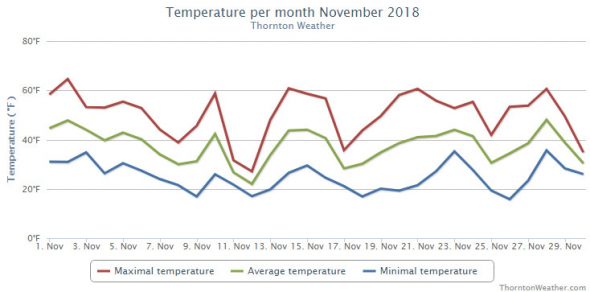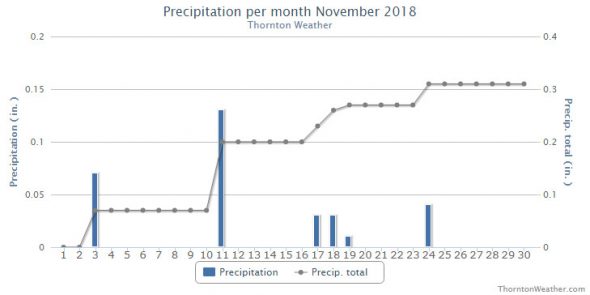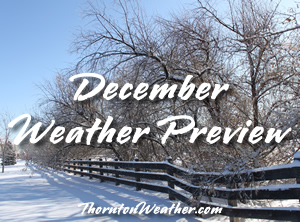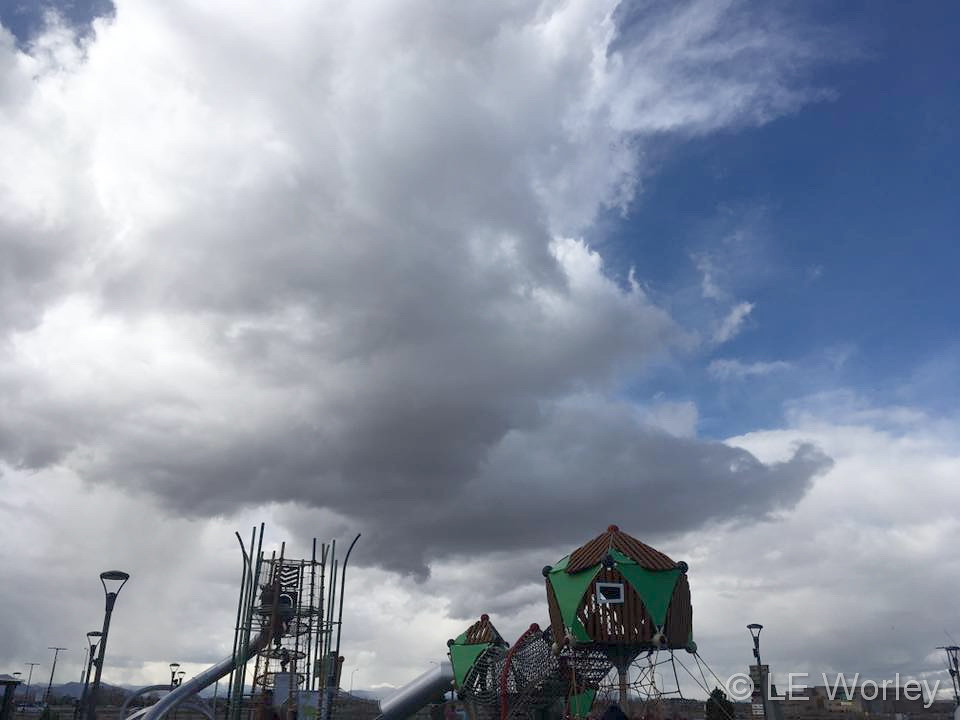
Heavy snow and damaging wind are at the forefront of our look back at this week in Denver weather history.
From the National Weather Service:
2-17
In 1939…more than 2 weeks of unseasonably warm weather made the month the 3rd warmest on record. Seven daily temperature records were set…including the all-time record high temperature for the month of 79 degrees on the 5th. Daytime highs were balmy with 14 days in the 60’s and 70’s. Low temperatures dipped to freezing or below on only 5 days. The period was dry with only a trace of snow on the 12th.
3-15
In 1972…a protracted cold spell held an icy grip on metro Denver when maximum temperatures never reached above freezing for 10 consecutive days from the 3rd through the 12th and minimum temperatures dipped below zero on eleven consecutive days from the 5th through the 15th. Daily low temperature records were set with 15 degrees below zero on the 5th…17 degrees below zero on the 6th… And 18 degrees below zero on the 10th. Daily record low maximum readings were set with 3 degrees on the 6th and 6 degrees on the 9th. The very cold temperatures were caused by 3 to 5 inches of snow cover and a Canadian air mass.
7-9
In 1919…an apparent arctic cold front brought extreme cold and light snow to the city. Snowfall totaled only 2.5 inches on the 7th and 8th. Temperatures dipped to lows of 14 degrees below zero on the 8th and to 20 degrees below zero on the 9th. Both readings were daily record minimums. High temperatures were only 4 degrees on the 8th and 7 degrees on the 9th.
In 1923…a major storm dumped 13.5 inches of snowfall on downtown Denver. The apparent post-frontal snowfall started during the late afternoon of the 7th and continued through the evening of the 9th. Temperatures dipped from a high of 66 degrees on the 7th with west winds sustained to 35 mph to a low of only 14 degrees on the 9th…with north winds sustained to 25 mph.
8-9
In 1943…4.5 inches of snow fell in downtown Denver. This was the only measurable snow of the month. North winds were sustained to 26 mph on the 8th.
In 2003…snowfall totaled 3 to 6 inches across metro Denver. Snowfall was heavier in and near the foothills with 8.0 inches measured in Boulder and 10 miles southwest of Sedalia. Snowfall was 3.9 inches at the site of the former Stapleton International Airport. Most of the snow fell on the 8th…as the snow ended shortly after midnight. North winds gusted to 29 mph at Denver International Airport.
In 2008…an upslope snowstorm produced heavy snow in and near the foothills of Boulder…Jefferson and Douglas counties… And along the palmer divide south of Denver. Storm totals in the foothills ranged from 8 to 15 inches. In Boulder and in areas west and south of Denver…storm totals ranged from 6 to 13 inches. The snowfall measurement at Denver International Airport was 3.9 inches.
8-10
In 1985 a slow moving storm dumped 10 to 20 inches of snow over the northeast plains…closing schools and businesses in many areas along the Front Range north of Denver. At Stapleton International Airport…snowfall totaled 9.9 inches with a maximum snow depth of 7 inches on the ground. North winds gusted to 24 mph. The snow caused long air traffic delays at Stapleton International Airport on the 9th.
In 1997…persistent light to moderate snowfall combined with strong and gusty northerly winds to produce much blowing and drifting snow across metro Denver. The hardest hit areas were south of Denver where north winds at speeds of 20 to 35 mph with gusts to 45 mph caused near whiteout conditions. The strong winds produced drifts 2 to 4 feet deep and dropped wind chill temperatures well below zero. Sections of both I-25 and I-70 and other roads were closed as travel became impossible due to blowing snow. Numerous traffic accidents were reported and a handful of people were stranded during the snowstorm. Snowfall totals included: 22 inches at Conifer…13 inches at Castle Rock…12 inches at Parker…and 8 inches in southeast Aurora. Snowfall totaled 5.5 inches at the site of the former Stapleton International Airport. North winds gusted to 36 mph at Denver International Airport on the 10th.
8-12
In 1932…the second longest sub-zero period on record in Denver occurred. The temperature fell below zero shortly after 1:00 pm on the 8th and remained below zero for 92 hours until 9:00 am on the 12th. The lowest temperature recorded during this period was 13 degrees below zero on both the 9th and 11th. That temperature on the 11th was a record low for the date. High temperatures of 4 on the 8th…5 below zero on the 9th…1 below zero on the 10th… And 6 below zero on the 11th were record low maximum temperatures for those dates. Light north winds at 5 to 10 mph were accompanied by occasional light snow…which totaled only 2.2 inches.
9
In 1898…the very cold air mass that settled over the city behind an apparent cold front on the 7th plunged temperatures to a low of 20 degrees below zero. The high temperature climbed to only 5 degrees.
In 1910…Chinook west winds sustained to 46 mph warmed the temperature to 60 degrees…the warmest reading of the month that year.
In 1919…the minimum temperature dipped to 20 degrees below zero in downtown Denver…setting a record low for the date.
In 1984…high winds occurred in the foothills with a gust to 69 mph recorded at Golden Gate Canyon west of Denver. West winds gusted to 36 mph at Stapleton International Airport.
In 1992…high winds were recorded over most of the day in the Front Range foothills. Wind gusts to 95 mph were measured in the Table Mesa area of Boulder. Northwest winds gusted to 43 mph at Stapleton International Airport.
In 1993…a weather observer in Boulder recorded a wind gust to 73 mph. North winds gusted to 37 mph at Stapleton International Airport.
In 1998…metro Denver and areas in the foothills received the first significant snowfall in more than a month. The upslope snow event deposited up to 17 inches in the foothills with generally 4 to 8 inches across metro Denver west of I-25. Snowfall totals included 17 inches at crescent park and 16 inches in nearby Coal Creek Canyon. Other snow amounts included: 16 inches at Tiny Town; 14 inches at Chief Hosa…Evergreen…and Genesee; 13 inches in Conifer; 12 inches at Nederland; 11 inches in Eldorado Canyon; 9 inches just west of Boulder; 8 inches in Boulder; and 7 inches in Broomfield and Golden. Only 3.6 inches of snow fell at the site of the former Stapleton International Airport. Northeast winds gusted to 26 mph at Denver International Airport.
9-13
In 1961…cold arctic air produced a protracted cold period. The temperature plunged to 16 degrees below zero on the 10th…establishing a new record for the date and the coldest reading since 25 degrees below zero on February 1… 1951. Low temperatures dipped below zero on 5 consecutive days with 9 degrees below zero on the 9th…16 below on the 10th…10 below on the 11th…and 12 below on both the 12th and 13th. High temperatures reached only 3 degrees on the 10th and 6 degrees on the 11th.
10
In 1953…snowfall totaled 3.8 inches at Stapleton Airport where northeast winds were sustained at speeds to 47 mph and gusted to 60 mph behind a cold front.
In 1969…sustained winds of 30 mph with gusts to 55 mph in downtown Boulder caused minor damage. Northwest winds gusted to 39 mph at Stapleton International Airport.
In 1980…winds to 60 mph whistled through Boulder.
In 1987…strong winds in the foothills spread over northern portions of metro Denver. Wind gusts of 60 to 75 mph were common in Boulder and southwestern weld counties. However… The highest reported wind gust…94 mph…occurred near Rollinsville. A northwest wind gust to 36 mph was recorded at Stapleton International Airport.
Continue reading December 9 to December 15: This week in Denver weather history




 November brought Thornton cooler than normal temperatures and a bit more snow than usual. What will December hold for us?
November brought Thornton cooler than normal temperatures and a bit more snow than usual. What will December hold for us?

